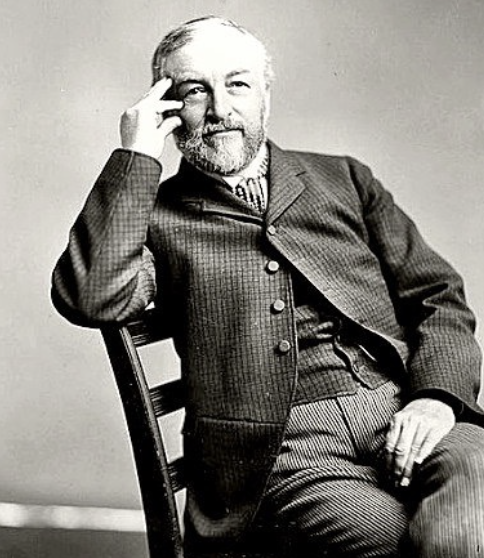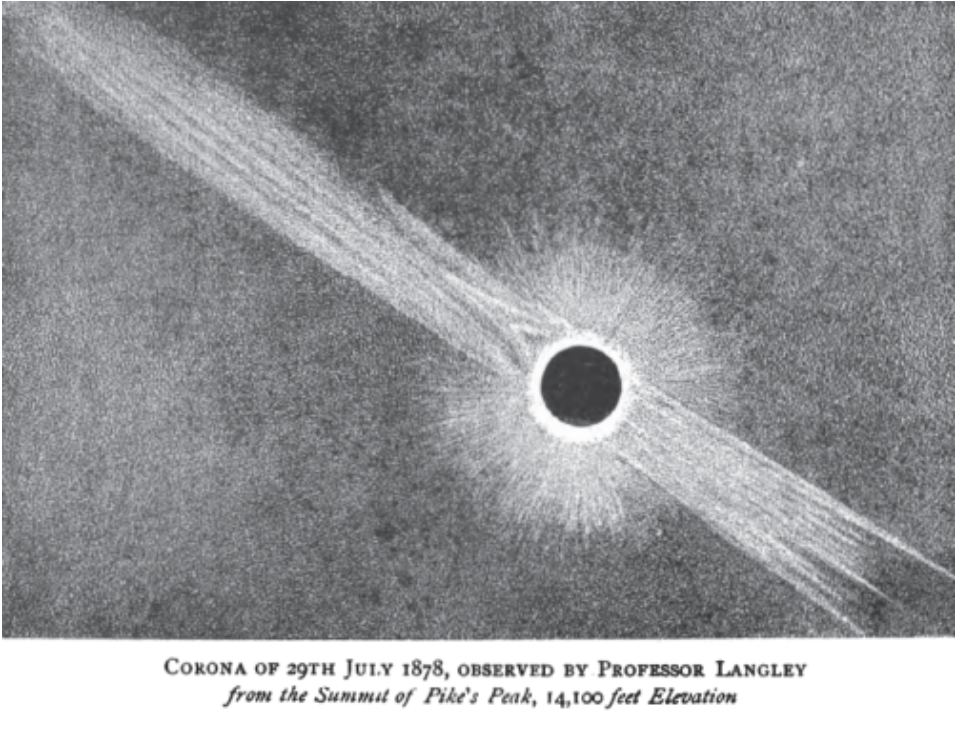 The first observatory on the Pikes Peak summit was set up by Samuel Pierpont Langley, Ph.D., L.L.D. in 1878, to observe the total eclipse of the sun on July 29. Langley, who had worked at Harvard College Observatory and the U.S. Naval Observatory at Annapolis, was Professor of Astronomy at Western University of Pennsylvania and director of the Alleghany Observatory.
The first observatory on the Pikes Peak summit was set up by Samuel Pierpont Langley, Ph.D., L.L.D. in 1878, to observe the total eclipse of the sun on July 29. Langley, who had worked at Harvard College Observatory and the U.S. Naval Observatory at Annapolis, was Professor of Astronomy at Western University of Pennsylvania and director of the Alleghany Observatory.
As reported by author Steve Ruskin in Colorado Heritage/Spring 2008: “A little more than a week before the eclipse, Langley and his team scaled Pikes Peak and set up their observatory, consisting of a large telescope on loan from the U.S. Naval Observatory and a few other instruments, all of which reportedly took a team of twelve mules five trips to bring to the summit…
“The [weather] conditions in the days prior to the eclipse were particularly nasty. Langley wrote of horrendous winds that battered his tent and ‘roared with a noise like that of a loose sail in a gale at sea.’ One morning, just a few days before the eclipse, he woke to find a ten-inch drift of snow lying next to him on his pillow. This was inside his tent…
“‘Hail, rain, sleet, snow, fog, and every form of bad weather continued for a week on the summit,’ recalled Langley. But on July 29, the day of the eclipse, the morning dawned clear and cloudless to the tremendous relief of everyone both on Pikes Peak and across Colorado. It would be a great day for an eclipse…
The Denver Tribune reported on July 29: “The observations of the eclipse today, made from the summit of Pikes Peak, were entirely successful.”

“The eclipse of 1878 was Colorado's scientific coming-out party, marking it the state's beginning as a favored location for scientific research.
Twenty years later Nikola Tesla would come to Colorado Springs to conduct electrical experiments in Colorado's high, dry air. In the short term, Colorado became a leader in astronomy in the American West. As a direct result of the 1878 eclipse expeditions, the Colorado College (founded in 1874) was the recipient of one of its first scientific instruments: a four-foot telescope brought in from Brooklyn to observe the eclipse, and afterward given to the college when donors purchased it from the astronomers who had brought it to Colorado.
“In 1888, just ten years after the eclipse, Humphrey B. Chamberlin pledged a whopping $50,000 to build and equip an observatory for the University of Denver. The Chamberlin Observatory housed a massive nineteen-foot-high telescope that was for a time one of the largest in the world. Other, smaller observatories would follow, and now Colorado has a number of active amateur astronomical organizations and societies. And to this day efforts continue by the National Space Science & Technology Institute to build [an observatory] on the summit of Pikes Peak.
“Most importantly for Colorado, however, was what the "great eclipse" of 1878 did for the young state's pride. The eclipse put Colorado on the map scientifically and, to a significant degree, culturally as well. Never before had so many people from all walks of life-simple tourists to the world's great scientists-descended upon Colorado for one major event. And with so much uncertainty about the weather until the very last moment, the anxiety and potential for major disappointment was high. But Colorado's weather held true-much to the citizens' pride and the eclipse went off without a hitch. It was an event that was celebrated across the state, across the country, and across the globe.”
In the Preface of Langley’s 1888 book The New Astronomy, Langley wrote: I have written these pages not for the professional reader, but with the hope of reaching a part of that educated public on whose support he is so often dependent for the means of extending the boundaries of knowledge.”